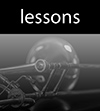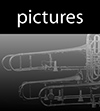We are in a career field of “Doers” where knowing the answer is never as valuable as the ability to do it "on demand". I know how to run a marathon, but that knowledge has very little value unless I put in the workouts. Many students and professionals know exactly what goes into being a great musician, but only a few people put the work in. Below is a list of skills that must be built into our intuitive automation with consistent, high-quality practice.
We, all of us, are often entrenched in casual routines. These careless practice habits can leave our artistry and technique in an arbitrary place - like dry leaves in the gale force winds of our auditions, gigs, and school obligations. I would never say you should curtail your obligations out of hand. Rather, we should DELIBERATELY strive in the direction we want our careers to go. But regardless of what your success looks like, we must all generate a sustained culture in our practice that drives us to succeed with the immutable truths I have outlined for you in the tips below. Remember, for practice to do its job, we must create reliable artistry and technique that is the default when we play, especially on our worst days. This default is only possible through the habitual commitment of our energy and time to the tips outlined below. Remember, practice makes PERMANENT!
1. Time, Tune, Tone - in that order!!
What you need - Metronome, Tuner, Recorder
A trombone teacher could design a zealous 4-year curriculum about nothing but Schlossberg, Arbans and the “THREE T’s”. I’m convinced that with near complete avoidance of musicianship in lieu of the THREE T’s, their studio would still have more success than most collegiate trombone studios for the simple fact that bad rhythm, unreliable pitch, and painful tone quality, even on just a few notes, is enough to kill a concert performance. Unfortunately, most college trombone undergrads actually CANNOT play most excerpts or a solos with convincing and consistent rhythm, pitch, and a golden tone quality. Arban’s and Schlossberg are my favorite books to practice these fundamentals.
Time
Consider or rhythm as the single most important item to engage any listener of your music making. A good performance goes beyond accurate rhythm and even convincing rhythm. A good performance conveys rhythm as an infectious pulse.
Think about it: A great song comes on the radio we might start bobbing our head or even tapping our foot along. Even if it is only subconcsious, music is actually a participatory art form. Compelling rhythm allows even the tone deaf listener to subconsciously feel like they are connected to a performance as a participating member. The infectious rhythm of your performance is the easiest gateway to positive audience or especially audition committee engagement.
How to practice: Never go faster than you can keep your rhythm surgically accurate. Start slowly with a subdividing metronome so your rhythm is accurate at the molecular level and speed it up gradually between each time you play the passage. Experiment with "Garage Band” (available on app store) by putting a groove to your metronome rather than just a click. You must learn to convey the meter of the piece you are working on to any listener. Practice performing for the recorder (Zoom Q8 or Sony MV1) without the metronome and then tap along with your playback to verify that rhythm is at very least, convincing.
Tune
Your reliable pitch is fundamental to your best tone quality, so it should be obvious that Tune and Tone go hand in hand. Anyone who would hear you play or play with you will not be convinced of your musical talent without reliable pitch. For you to be convincing with your tuning, the skill has to be so good that it is instinctual.
“Pretty good” pitch is demonstrated well by keeping the tuner needle straight up as consistenly as possible. I love to practice long tones using the "tunable app" on my iPad or iPhone, which turns good, steady pitch into a game, however, there is so much more to good tuning than that. A smart musician will also take into account the function of their note in the chord or even the solo melody. For example, if we have an Eb in an F dominant 7 chord, we know to adjust way down to play in tune with the chord. In a solo melody, we must identify the harmony of our linear melody to line up the just pitches. A great example of this is in the first two phrases of “Tuba Mirum” or the entirety of the “Die Walküre” opening to Act 3 excerpts, of which both melodies are extremely chordal in nature. I like to practice out of the Stephen Colley book “Tune Up Boot Camp” to train my ear to hear when I’m playing the 3rd, 5th, and 7th of the chord so my adjustments in performance are accurate and instinctual.
How to practice: Train your ear, not your arm. Emerge: Start with a tuner and your long tones - keep the tuner true through a variety ranges and dynamics by practicing steady tones, and then hairpin dynamics. We will often unconsiously bend the pitch slightly as we traverse the dynamic range. Play your etudes and exercises with a tuner on the stand but only look at it occasionally to affirm that what you think is in tune actually is. This is a lot like knowing how to do arithmetic without a calculator. Evolve: Practice scales with a gentle drone (Colley Book and CD) - Play it each scale slowly and make the beats go away on every interval.
Remember, music performance is generally a community endeavor so your ability to tune with others is absolutely crucial!! If your pitch doesn’t agree with the person you’re performing with, and neither of you adjust, YOU’RE BOTH AT FAULT!! The trombone is basically a mouthpiece, a tuning slide, and a bell so there’s never an excuse to be out of tune.
Tone
Take the greatest responsibility for your sound. Become a tone phenom and cultivate your sound as if it’s the connection to your whole identity as a player. Ideas about compelling sound should dominate your thoughts from when you wake until you rest. Your sound is unique and when you get close to it, you will find that it becomes more and more effortless to play the trombone. Take special care that nothing gets in the way of your good tone, like heavy-handed articulation, lazy slide technique or, conversely, flexed right bicep slide technique, tight throat, labored breathing… the list goes on and on. In the words of the great Sam Pilafian, “Tension Kills Sound!!” (Breathing Gym)
Errol Flynn is quoted that holding a sword is like holding onto a baby bird. “Hold the bird too tight, and you kill it. Hold the bird too loose, and it flies away...”
This analogy works perfectly for tone production because relaxed, supple lips generally make the best tone, but we all know that the suppleness is not entirely devoid of structure or strength. Therefore, I have an equation that I use to explain tone production.
Strength + Air = Tone
Let’s pretend that the best “Tone” in this equation is 100. Because we know that tension kills sound, ideally, we have very little Strength 10, plus fantastic Air 90, to give us the perfect Tone 100. But we can also play with the numbers to sound aggressive with too much Strength 20 and too much Air 99 to get a sound that is steely and unblendable at 119. Obviously, it works the other way as well to get a number for Tone that is less than 100 and sounds tentative and anemic.
When your teacher says, “More Air!!” What they really mean is more air, but less strength. You must have noticed by now that strength with more air does allow you to play louder with better response, but with heavy air flow and too much strength, it becomes difficult to play dolce as response problems will begin to plague your phrases.
Because tension kills sound, good tone production becomes a game where we always try to get away with less strength, but always to make up the difference with better breath support.
How to practice: Always begin with the end in mind, my friends. You should always start your day listening to what you want to sound like. I cannot stress this enough. Find the greatest examples of tone production (my favorite is great trombone soloists or especially tenor vocal arias) and begin each day listening to them or watching them on YouTube. The idea is that you will learn their sound and copy it’s color as best you can.
Practice hairpin long tones from soft to loud (breath) and then loud to soft. Never play so soft to be tentative where articulation is unreliable, never play so loud as to be aggressive and steely. Memorize what your golden tone sounds like and what it feels like when you play as beautiful as you can throughout the dynamic range.
Always remember that great tone has very little effort. Your sound should always be vocal with as little strength as possible. So, be mindful of whenever you feel muscle fatigue (not just in your face, but anywhere in your body) as this is an indication that you are inefficient and headed towards a sound that is painful to listen to.
2. Inspiring Musicianship
My friends, from one trombone player to another, let’s be honest; in general, trombone players are not typically referred to as the most compelling musicians. It’s not just you, and it’s not just me. Great composers followed tradition to write career-defining operas, symphonies, but also concertos for piano, violin, flute, oboe, and horn. Even trumpet, cello, and viola, VIOLA - the butt of every great musician's joke, gets more solo devotion from history’s great composers than the trombone as a matter of tradition. As a result, we bellow from the back of the orchestra with perfect bricks of sound and general moo cow sounds.
The legacy of this has made our niche this way for hundreds of years now, which is why you can fill a building of many rooms with all the violin solos and concertos that have ever been written and you can only fill a couple of large file cabinets with all the Trombone solos and concertos in history. We trombonists love to play for each other, and yet, when we win our big jobs, we will likely be hired by a committee or music director who are not trombonists. Therefore, we would do well to make our music more universally convincing STARTING TODAY!!
When we discuss music as an art form, there is so much more than volume, technique, and consistency that goes into compelling musicianship. Can you remember what gripped you about a recent trombone recital beyond quick technique or loud playing? What about dynamic pacing, rhythmic variation, tone color, variable articulation, sotto voce, etc... the list goes on and on. The point is, if we do not take deliberate responsibility to elevate our perception of musicianship we run the risk of being just another trombonist that places volume as the height of artistic prowess.
As trombonists, we need to change position moving forward by developing our inspiring musicianship. To be an inspiring musician, you must take daily responsibility in your practice to be inspired. This is most effective with live concerts, but also video and audio recordings as well. In the absence of live inspiration, iTunes, Spotify, and YouTube are all great resources - it only takes a few minutes a day! Listen closely to your teacher's demonstrations as this is one of the most crucial sources of inspiration. Just like the development of any skill on the trombone like endurance or high range, think of world-class musicianship as a puzzle that you must figure out if you yearn to be a professional musician.
That’s not to say that all of the other things discussed here don’t deserve a great deal of your attention, but if we were all of a different instrument group, we might discuss them as waypoints on the journey to greater artistry. And this is my point to motivate your practice even higher than it already is - There has to be more to your performance ambition than not missing any notes and being able to play really loud. Make you musical goals as specific as possible. Aim big, miss big - aim small, miss small.
How to practice: listen, Listen, LISTEN!!
Start by listening to world-class musicians that are not trombonists. Find a recording or video of a vocalist or pianist, violinist or cellist that you find interesting or compelling and try to work out why they might get paid 100x’s more than any trombonists ever could. There are musical events that have to do with adjusted rhythm, timbre, and dynamics, both grand and subtle, that make a compelling performance greater than the sum of its parts.
Start first with exposing yourself to this artistry in the effort that you might become infected by it. Watch how these great artists breath, when they choose to match and blend in, as opposed to sticking out of the texture, via volume, articulation, and or timbre. Observe style and note shape or even facial expressions. Ask questions if possible for where these great artists acquired their inspiration, where is their focus as they perform, etc..? Some of these things are not directly applicable to trombone performance process and that is okay. So many of these are elements of style that you can steal!! It will become your job to combine these ideas, observed or explained, to explore your own artistic agenda so that your performances become more than perfect bricks of sound with good rhythm and pitch.
3. Adaptable Musicianship
The backbone of any great musicians is a strong musical agenda, but also a nimble flexibility to the moment. We as trombonists are most often members of an ensemble, whether in an orchestra, band, or with a pianist. Thus, we make a living playing with others. Great artists that we are and aspire to be, we must acknowledge that music is always collaborative in some way and all of our technical prowess and inspiring musicianship must always be adaptable to the ensemble, conductor, and the concert hall.
Adjust the culture of your performance technique to understand that most often we do not get to be the artistic director of the orchestra, nor do we have the melody very often. Moreover, understand that conductors are not metronomes, and yet they dictate time. Also, soloists are not perfect, nor are they consistent from night to night, yet their style and note shape brings patrons by the truckload and you must learn to match their performance. Your colleagues are not tuners, and yet when you accompany their melody, their hauptstimme must govern your rhythm, pitch, volume, and timbre. The elephant in the room here being that as trombonists, most often we often do not have the most important line and we are certainly not the artistic director.
We must be great musicians with good enough technique and a generous enough spirit to remain adaptable. We learn the THREE T’S that are so important, are also bendable to the needs of the melody and the conductor. Surely you know the lonely road of the solitary practice room, day in and day out. Just remember the old saying by Theodore Roosevelt, “He who travels farthest travels alone, but the goal thus reached is not worth reaching”. In music you perform best when you stay together.
How to practice - 3 prongs:
- Research. You need to study the score to know where the melody is at all times. This will help you to understand and stay flexible to pitch, rhythm, timbre, and especially volume. You will know when you have the melody and thus to lead with all the charisma in your arsenal. Conversely, if someone else has melody, you can watch them, listen, and stay flexible to their style and execution so they don’t have to work so hard to compete with your contrasting voice or rhythm. Music is not about being right. Do you research so you can help everyone sound their best.
- Study Pure Harmony. Anything short natural tuning puts two pitches in adversarial roles and makes everyone’s job difficult. I mentioned it as a crucial element of the second "T" but I love the Stephen Colley book, “TUNEUP” which can train your ear to hear natural harmony intervals. You will quickly know which direction to move and produce natural tuning on any chord as opposed to equal temperament which can make it comparatively difficult. For example, if you have the major third of a chord and you do not adjust slightly down, consciously or not, you will force all the musicians around you to play higher simply because they are more responsible for pitch than you. At the end of the day everyone is much more tired than they should be and who’s not going to get tenure? That’s right - YOU!! I use Stephen Colley’s book in my practice all the time just to keep my ear instincts intact. Pure harmony is based on the physics of intervals working together and has elegant mathematical solutions than immobile cacophony. Remember, it is not enough to know the answer, you need to live the answer enough that it becomes instinct. Thus, your ear will put your slide in the right place every time. It is very difficult to perform with people who don’t adjust to natural harmony
- Chamber music. Are you in a brass quintet? You need to be. Here is where you will learn how to listen and adjust to your colleagues with room to respectfully discuss artistic agendas in such a way that everyone hopefully leaves rehearsal with their pride intact. I don’t mean to brag, but in a statement of fact, I always got tenure when I won auditions and I attribute my consistent brass quintet work all through college and beyond as the strongest reason why. As I said before, music is a collaborative art form and in a brass quintet, you learn to match tone, rhythm, and style with the brass principals and how to blend overall artistic goals to a great concert performance.
These three things must be practiced in tandem as they are all important as the fundamental to world-class musicianship.
Epilogue
Practice takes time. Before I got an orchestra gig that paid the bills, I felt like I was playing a long poker game with Fate, but instead of money on the table, we are all of us, always betting time; practice time, listening time, rehearsing time, etc... All time not spend learning another vocation or enjoying my youth. The amount on the table is always going up and at some point, I was going to either win the game (orchestra job), or I would need to step away from the table and give up on trombone forever. With music, we all have our own poker game with fate. And whether we acknowledge it or not, we know it is safer to watch the poker game than to actually play it. So many of us observe others and pretend that knowing what we should practice is just as valuable as actually doing it. Ask yourself, are you in the business of knowing, or doing?
We are in a career field of “Doers”, not “Knowers” and the only way to build the ability to do all of the things in this article is to dedicate enormous portions of your time and emotional energy to make The THREE T’s, INSPIRING MUSICIANSHIP, & ADAPTABLE MUSICIANSHIP a surety of automated intuition, even on our worst day. I never wanted to do anything else but play trombone. For a long time, it wasn't working for me until I gave myself a cutoff date (age 30) that I would stop taking auditions and learn a new craft. If that's a good plan for you, it can be a way to make certain you're not playing too long at the poker table with Fate. If you feel like I did and you don't want to do anything else, then I encourage you to go all-in my friends. Do not waste your time with sub par practice that is beneath your potential. You know what to do now so the only thing left is to get out and do it!! It won't all be roses and rainbows, but do try to enjoy building your good work, one day on another because good work quickly becomes obvious and the knowledge that you made it happen is empowering.
Music is the greatest art form that ever existed. Dedicate yourself to your part in it and you will either discover that you don’t really want a career on the trombone or that the success you hoped for really wasn’t so far away. Always remember that it takes 1,000-10,000 private victories in the practice room before you can hope to celebrate a public one in concert so... GET TO WORK!!












